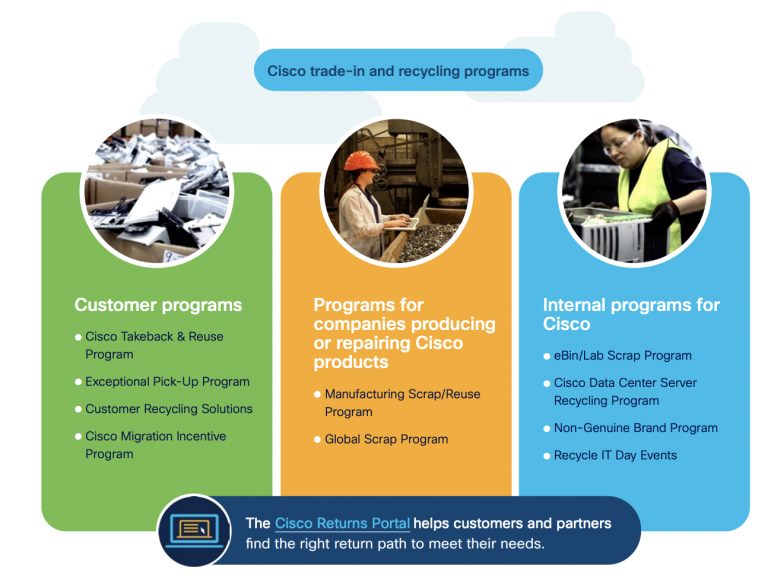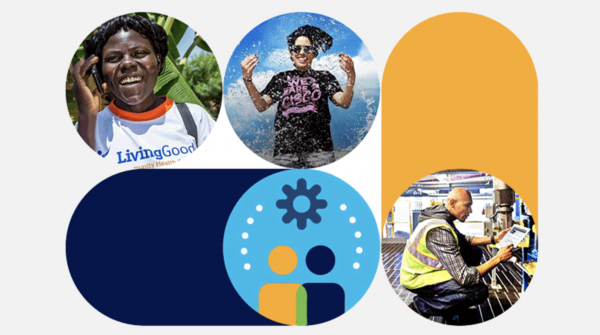The following is based on an excerpt from the 2020 CSR Impact Report, published on December 8, 2020.
Central to the concept of a circular economy is maintaining assets at their highest and best use for as long as possible. As Cisco transforms to a software- and features-driven business, we must not lose sight of the importance of our hardware in enabling those solutions. At the World Economic Forum in 2018, our CEO joined forces with the Platform for Accelerating the Circular Economy (PACE) in signing the Capital Equipment Pledge, committing to 100 percent product return upon request, at no cost to our customers.
We continue to make progress toward that commitment, as well as our broader circular economy vision. This progress builds on close to two decades of programs to facilitate product returns for reuse and recycling, offer comprehensive service and repair, and remanufacture used equipment for sale through Cisco Refresh. Our strategy focuses on improving the customer experience to drive increased product returns at end-of-use, expanding business and as-a-service models to facilitate return and reuse, and improving product design to facilitate reuse and recycling. Our programs aim to extend the useful life of our hardware and are organized by product lifecycle stage—from use, to return, to reuse and end of life.
Use
The use phase is critical for integrating our circular economy approach into the lifecycle management of our equipment. Cisco’s Global Service Supply Chain organization delivers and supports customer and partner hardware Return Material Authorizations (RMAs). We are constantly optimizing our network and inventory levels as parts are used, customers deploy new products, and old hardware becomes obsolete. To maximize products’ useful life, we replace, recover, and refurbish equipment and components as necessary through an extensive logistics, warehouse, planning, and repair operations network. Each device is repaired and repeatedly tested to ensure compliance with the latest manufacturing specifications.
End of use
 Returns: End-of-use is not end-of-life. Enabling multiple lifecycles for our products and the components inside them has long been a Cisco priority. We operate multiple programs to take back, refurbish, and reuse products at end-of-use, including 10 different programs to support our product trade-in and recycling efforts. These are designed to support the needs of our customers, suppliers, partners, and internal users. Read more about these programs in the ESG Reporting Hub. Information on our compliance with product recycling regulations, such as the Waste Electrical and Electronic Equipment (WEEE) can be found here.
Returns: End-of-use is not end-of-life. Enabling multiple lifecycles for our products and the components inside them has long been a Cisco priority. We operate multiple programs to take back, refurbish, and reuse products at end-of-use, including 10 different programs to support our product trade-in and recycling efforts. These are designed to support the needs of our customers, suppliers, partners, and internal users. Read more about these programs in the ESG Reporting Hub. Information on our compliance with product recycling regulations, such as the Waste Electrical and Electronic Equipment (WEEE) can be found here.
Reuse: Reuse is always our first priority. Returned devices that can be reused are remanufactured, refurbished, or repaired, and resold by Cisco Refresh or used by Cisco CX Service Operations or our internal labs. Any products that are not reusable are harvested for components and recycled by one of our authorized recyclers.
Cisco Refresh, our certified remanufactured equipment program, plays an important role in our circular economy initiatives, creating a second life for equipment and thereby not only saving the resources required for new manufacturing, but also reducing waste. Cisco Refresh products are backed by the same Cisco warranty and service options as new products. Equipment is sold only through Cisco authorized resellers and is available in more than 80 countries. Inventory includes products from all technology areas, including switching, routing, wireless, IP telephony, security, and other advanced technologies.
We also reuse product in our Return to A-Stock program, where unused products from our distribution centers are sent to be reused by our contracted manufacturing sites. In fiscal 2020, Cisco expanded this program from nine sites to 10. Returned products that are considered “new-in-box” are sent back to be tested and, if necessary, reconfigured. This allows us to better reuse these products while also improving our ability to satisfy demand for new equipment without new manufacturing.
Alongside our efforts to increase the reuse of used equipment, we must also address external barriers in order to scale these opportunities. We collaborate with peer companies, NGOs, and policymakers to address challenges and unintended consequences, such as the many global classifications of waste for transboundary movement which can impact our ability to repair equipment.
End of life
When products can no longer be used, they are sent to recyclers to be responsibly harvested and recycled. We currently have two contracted recyclers. Each recycler uses both company-owned facilities and subcontracted recyclers to provide global recycling coverage. Cisco’s contracted recyclers are required to be certified to one or more e-scrap-specific recycling standards, such as R2, R2 Rios, eStewards, and WEEELABEX. Our contracts also require recyclers to enforce our strict recycling processes with any of their subcontractors recycling Cisco materials. For more information, please visit our ESG Reporting Hub.
Harvesting: To redeploy as much material as possible, Cisco allows our recycling partners to harvest commodity components from the equipment they receive. Recyclers may harvest processors, memory, and other nonproprietary hardware with sufficient market value to offset the cost of their harvesting, cleaning, packaging, and resale. In fiscal 2020, our component harvesting program allowed more than 120 million components to be reintroduced into the market, thus extending their useful lives and reducing the need to manufacture new parts.
Recycling: Recyclers are the last resort after we have exhausted all options for reuse. They are the common destination of all end-of-life materials, including customer returns, employee office equipment, and lab equipment, as well as excess, obsolete, and damaged materials from our contract manufacturers, manufacturing partners, original equipment manufacturers (OEMs), original design manufacturers (ODMs), contracted repair partners, and distribution depots. A map of our recycler locations can be found on our ESG Reporting Hub.
Of products sent to our e-scrap recyclers, in fiscal 2020, over 99.8 percent were broken down into commodity fractions and sent to downstream vendors to create new products. Since fiscal 2019, our target has been to keep the percentage of material sent to landfill after initial processing under 0.38 percent. While we continue to aim for decreased material sent to landfill, we also recognize that Cisco has limited control over the material received at the recycler (for example, a customer’s choices in packaging). Therefore, we expect our landfill percentage to remain consistent annually.
In fiscal 2020, we saw an overall decrease in return volume coupled with an increase in our reuse, resale, and refurbishment rate. Some of the decline is due to site access limitations due to COVID-19 restrictions, as well as a decline in returns of unused products. However, returns at end-of-use have held steady, and this is the area we are focused on for growth. Increases in reuse can be attributed to incremental improvements in the channels for reused or refurbished equipment, an area where we made progress in fiscal 2020, despite challenges related to COVID-19. We continue to explore opportunities to use recycled content in our new products. The summary table above highlights recent changes across our key KPIs; multiyear progress on these metrics can be found on our ESG Reporting Hub.
To learn more about the progress we’re making to power a more inclusive future through CSR, visit our Cisco ESG Reporting Hub, where you can read our CSR Impact Report.



CONNECT WITH US